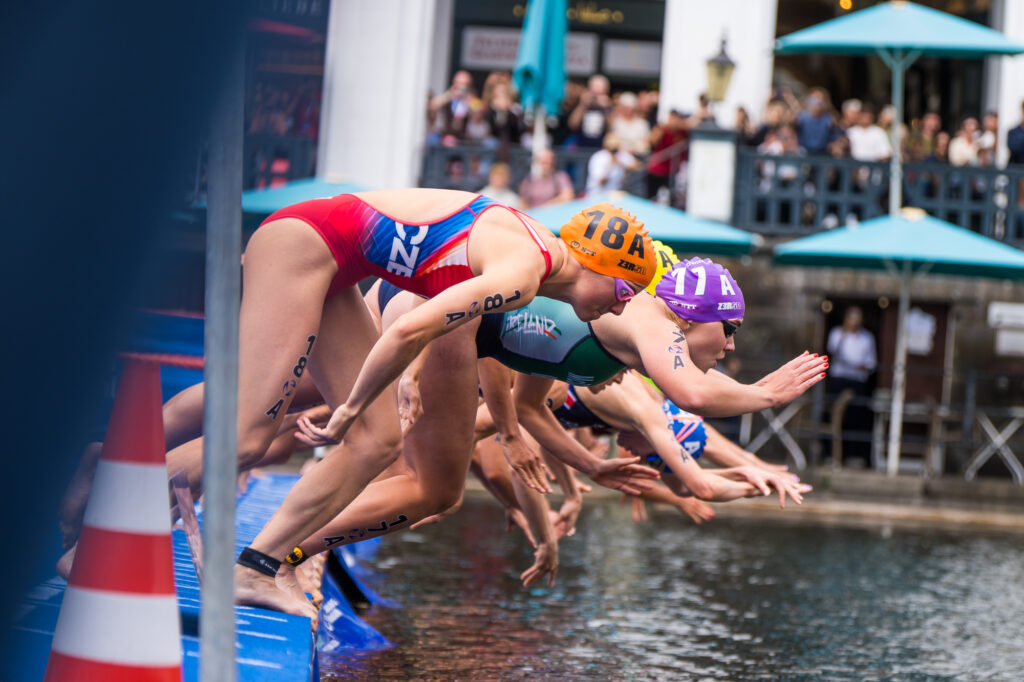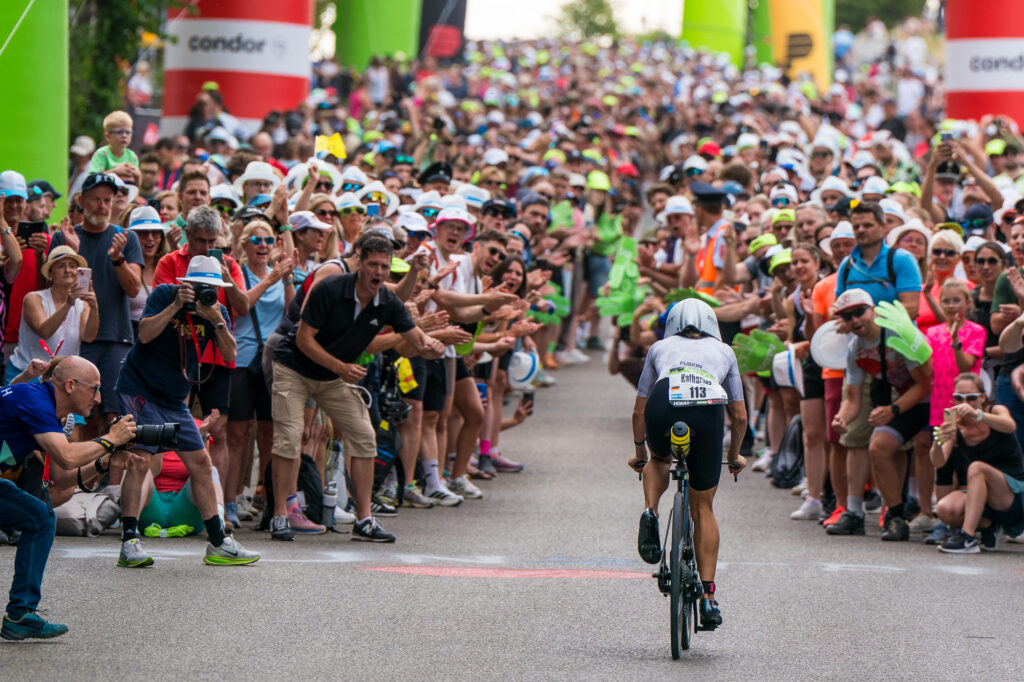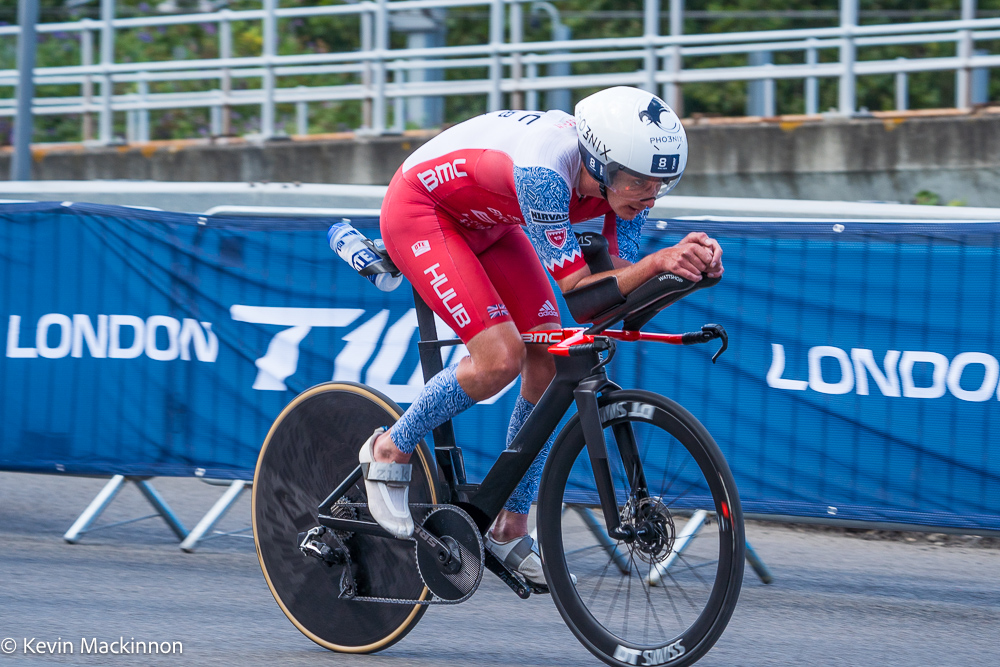T100 Distance in the Olympics? World Triathlon Looks for a “Bold Shift in Mindset and Structure”

The start of the mixed relay in Hamburg last weekend. Photo: Kevin Mackinnon
There was enough exciting racing going on last weekend at the World Triathlon Championship Series Hamburg event that we didn’t really get around to reporting on the “event summit” that was taking place at the same time. At the summit World Triathlon released a report – “Future of World Triathlon” – which was put together in partnership with Deloitte.
You can read the full report here.
A 100 km Olympic Event?
While it wasn’t included in the report (as far as I can see, anyway), one of the topics that came up in the discussion at the summit was the inclusion of a T100-distance race at the Olympics at some point.
“The potential inclusion of the T100 distance in the Olympic program is exciting and could significantly enhance the sport’s global appeal, offering a more accessible and spectator-friendly format,” Professional Triathletes Organisation (PTO) CEO Sam Renouf said during the panel discussion. “We are eager to explore how we can work with World Triathlon to make this a reality.”
While it sure would be fun to see a long-distance race at the Olympics, making that “a reality” sure seems like a stretch. All indications are that the Olympics are doing everything they can to keep the athlete numbers the same (10,500), or even decrease them. Adding events seems to be fine, as long as the overall numbers don’t grow. So, a mixed relay works. Adding an eliminator or SuperTri type race might also work since it would still involve the same athletes. Adding a long-distance race? While some Olympic-distance athletes are great over the 100 km distance, very few could excel at an Olympic-distance race and a long-course event within a week of each other. So, to add the 100 km distance, you’d need to add athletes.
With Australia hosting the 2032 Games, and it being a tri-friendly country, one would imagine there could be some appetite for a demonstration sport added to the mix. Whether or not a three to four hour race would be attractive compared to something shorter and more dynamic seems to be the big question, though.
Even though it seems like a long shot, the fact that it was even being discussed shows the upside for the PTO’s partnership with World Triathlon, which provides both exposure and global recognition. As you’ll read below, the PTO could very well be positioned to take on a larger role within World Triathlon beyond its current partnership.
The Future of World Triathlon
The report, or, as the intro puts it, a “joint initiative between World Triathlon and Deloitte” (I would love to know how much World Triathlon paid Deloitte for the study), “was launched in light of an important paradox: while interest in health, fitness and endurance sports is on the rise globally, participation in triathlon has stagnated – or even declined – in several key markets.” It’s an interesting read, filled with lots of interesting suggestions for how World Triathlon can and should change to become more relevant and to become more of a commercial success.
Here are a few takeaways:
Triathlon Events “Fragmented Landscape”
The global triathlon landscape is highly fragmented. At the international level, the sport is shaped by a complex web of private organisers, committees, public authorities, federations and clubs— each operating with distinct goals and formats.
You think? The report sites that there are over 20 different race formats in the sport. There are a bunch of different world championships and even those involved in the sport are easily confused by all the different options.
“As the international federation, TRI (World Triathlon) must be seen not as a regulator or a competitor, but as an enabler,” the report states. “To unlock triathlon’s full potential, collaboration and enablement must replace fragmentation. Only then can the sport scale – and succeed – on the global stage.”
Those of us who are old enough to remember the World Triathlon/ IRONMAN battles of the old days are certainly thrilled that there is much more of a sense of working together these days, but the folks from Deloitte certainly seem to be indicating that there’s even more work that can be done on this front.

“Mass participation remains the sole profitable segment across organisers.” Athletes head up Solar hill during Challenge Roth. Photo: Kevin Mackinnon
World Triathlon Events are too Expensive … Mass Participation is Where the Money Is
The report cites a $300,000 price tag for putting on a World Cup event (it only gets more expensive for a World Triathlon Championship Series race) “with nearly a third going to fees, officials, anti-doping and sanctioning.” The report, which lauds USA Triathlon (USAT) as “one of the few major national federations that operates on a fully sustainable business model based entirely on private funding,” notes that this is why we don’t see very many elite races in the US. Hosts that are putting these races on are doing so with the support of public funding – read government support. Because these elite races aren’t profitable, USAT can’t afford to take them on.
“World Triathlon events rely predominantly on government funding (40-50%), with limited revenue from registration (20–30%), sponsorships (7–10%), expo (5–7%), and other sources (2–3%), resulting in many events struggling to break even, especially if they are Elite-only and can’t rely on registration revenue,” according to the report. “Private organisers like Ironman and Challenge achieve profitability through lower technical costs and stronger revenue streams in participation, sponsorship, expo, and merchandising … Mass participation remains the sole profitable segment across organisers, but without reinvestment and a professional growth strategy, this will not continue to be the case for World Triathlon.”
This backs up the feeling that the PTO could never make a go as a professional race series – it had to become an events company if it were ever to be able to make money.
The report goes further on that front:
“Most elite sports generate revenue from broadcasting rights, sponsorships and ticketing. For World Triathlon (and other event organisers), this model is harder to achieve: it lacks control over athlete (and even event) image rights and holds many events in open-access venues with limited ticketing potential.”
Mass Participation
The report suggests that World Triathlon “reprioritize focus areas” that includes high-profile events to “attract sponsors and media,” and allocate resources “between elite competitions and mass participation.”
World Triathlon does have some successful mass participation events – the age group world championships over the various distances. Those events don’t seem to get the same emphasis as the elite racing, though – something the report seems to agree with.
“Critically, mass participation cannot be treated as a secondary or supporting activity; it must be seen as a high-priority business opportunity. Without dedicated focus and innovation, there is a real risk of losing market share, forfeiting valuable revenue, and missing the chance to use these events as powerful platforms to elevate the sport’s overall visibility and commercial appeal.”
The report also suggests that World Triathlon “should also develop revenue streams like certification courses, workshops, coaching and academy services to strengthen finances and grow the sport.”

T100 London
A new Commercial Entity as part of World Triathlon – is that the PTO?
To be able to separate itself from governing the sport while also putting on events, the report suggests that World Triathlon follow the International Volleyball Federation’s (FIVB) lead and set up different entities within the organization. Setting up a commercial entity separate from World Triathlon’s governing arm would create a division that could focus on putting on races. (FIVB has a third entity – a Foundation – that “focuses on grassroots development and promotion.”)
Is this possibly where the Professional Triathletes Organisation fits in to the picture? Now that it’s putting on events and looking to attract age group athletes, the PTO is certainly setting itself up to be able to fill that type of role. Later this year the PTO will be putting on an event alongside the world championship in Wollongong, which could set up a template for future cooperation on that front. Add in a 12-year partnership deal between the two entities, and you have the makings of a win-win situation for both sides.
Enabling vs Competition
“World Triathlon is well positioned to grow, building on several key strengths: a strong global network of National Federations, its unique role as the sole Olympic pathway for athletes, several profitable businesses lines, trusted relationships across the sport, and deep technical expertise. These assets form a solid foundation for future commercial expansion.”
World Triathlon will face some interesting challenges as it looks to build out on these suggestions from the report. (I hasten to add that I’ve just picked a few takeaways – there’s lots in there.) It certainly makes sense for the federation to take over its mass participation races to earn revenue from those events, but if it were to try to expand beyond that it will be stepping into the realm of race organizers its supposed to be supporting. Ditto for other revenue streams like coaching certification and workshops – the national federations are using that as a revenue stream at this point.
The report does emphasize, though, how important collaboration will be to World Triathlon’s growth.
“Collaborate more actively with private organisers who have already built commercial and operational capabilities,” it states. “Growth depends on shared ambition, not competition within the ecosystem.”
At the end of the day, that seems to be the overarching message from this report – triathlon is only going to grow if everyone works together to make that happen. There was a huge change in terms of cooperation and collaboration in the sport when Marisol Casado took over as the president of World Triathlon 16 years ago. Her successor, Antonio Arimany, appears ready to embrace even more collaboration within the sport based on this report.
Tags:
DeloitteFuture of TriathlonMass ParticipationOlympicsProfessional Triahtletes OrganisationWorld TriathlonContinue the discussion at forum.slowtwitch.com
9 more replies




I keep hearing this said, but it seems to operate under the assumptions that new entrants are asking the IOC/federations to foot the bill. Which is a reasonable assumption.
But what if the PTO simply said they would pay for all of the athletes. Wouldn’t that be a better path towards a viable product as opposed to paying out annual contracts?
PTO wouldn’t have to pay a single contract next year – simply commit to fund the races and the athletes during the actual Olympics and let the athletes fight for their slots and self fund, federations fund, etc.
If you want to race in the T100 in the 2032 Brisbane Olympics, require commitment to the format now and plenty will start lining up without contracts.
I’d rather an Ironman race if we’re gonna do dumb things at the Olympics!
This simply isn’t going to happen. All changes to Olympic inclusion must be neutral headcount increase. The major limitations are accommodation and coverage time. There is no way a 4 hour triathlon is going to replace the OD and Relay races.
There isn’t the popularity or the demand for it.
Additonally, Long Course is not a funded sport. It would have to go through a full Olympic Cycle and get approval from the majority of the NGBs to push ITU to have it included. British Triathlon (like all the other major federations) do not fund LC athletes. The funding they do receive cannot be spent on LC athletes because it isn’t an Olympic Sport. Chicken and egg situation.
3 words tell more than 27 283 words:
Never. Gonna. Happen.
This is a horseshit promo by the PTO, now assisted by ST. I would rather have seen some race coverage to be honest
To each their own though…
It is a bit triathlon…the format in the Olympics is the most foreign (and likely hated) by people in the sport but because it has the pole position already established in the Olympics, no other format can really even get their foot in the door. Yet other sports have seemingly every version of their sport represented in the Olympics, but god forbid little ole triathlon wants to expand, we get put in our place immediately by PTB’s…it almost perfectly entails the struggle our sport has…
Kinda how Hookless is getting promoted…or feels like hookless is getting promoted.
Seeing as they don’t want to add more athletes I don’t see it happening. Additionally it falls outside the 2 hour limit I think they are aiming for.
As this is not going to happen as a triathlon race I think it would be interesting to see which country can put together the best relay team for the T100 distance.
Far more interesting than teeth gnashing over a throwaway observation by the PTO during a general ‘chat’.
I’ll play:
GBR:
Leah Crisp 16:30 for 1500m so 1:06 pace so for 2km: 22 minutes (NB LCB not far behind) there is a wunderkind on 16:10, but too young for relays.
Anna Henderson 41:09 for 32.4km ITT (Paris) so 99 minutes for 80km
Eilish McColgan 65:43 for a half
That would be a pretty solid team. US women would most likely be strong as well. Don’t know who would do the running, but Ledecky+Dygert would most likely come in to T2 first. Maybe let Gwen have a shot.
I think one of the many problems is that the marquee event (the Olympic distance triathlon at the Olympics) is a close but different version to what people can participate in. Most people do olympic distance triathlons on tri bikes with no drafting allowed. AND this format in its elite form (with drafting) is often making the bike part boring to watch (but still better than watching a long course race).
I think this race (and most/all WTCS and World Cup/Conti cup races) should change to the Enduro format. You don’t need to make it much shorter like SuperTri, just break the Olympic format into 3 triathlons. Many more transitions, and many more opportunities within the segments for exciting changes in race dynamics, keeping the audience on its feet for the full two hours it would last.
To go back to the roots of our sport, and age-groupers associating themselves more with the ITU studs, you could hold a qualification event with let’s say 60 athletes over the time trial format (straight spring distance event, in time trial format, on road bikes to keep it simple). The top 30 or 40 go to the final to do the Enduro event (something like 800 swim, 13k bike, 3,3k run, 400 swim, 13k bike, 3.3k run, 400m swim, 13k bike, 3.3k run).
I think that would make for an exciting race. And you have to be very strong in all three disciplines to qualify.
I like it but the issue is then this would still not work for normal races with road closure issues and health and safety considerations for Joe blocks in the swim.
All changes to Olympic format now have to be for mass participation events. T100 is never going to be in the Olympics and ITU will be furious at this silly publicity attempt.
They have enough on their plates with the corruption findings published this week.
If anything the OD race will become a Sprint Distance race and the relay will stay as is.
The concept of a non-drafting Olympic race is very interesting to me. I can watch a T100 (or 70.3) non-stop, but every time I see a peloton in the Olympic distance I get bored or annoyed at how they race.
However, they won’t sacrifice the relay and so it makes little sense to change the distances.
I envy you (the first part).
To me, it’s all about the course. Look back at how the Rio race went and compare it with Paris. Or WTCS Weihai 2024 (Wilde getting dropped on the bike! goodness me) versus a place like Yokohama, and T100 San Francisco versus London.
No format will rescue an event planned on a boring course, and conversely, I’ll stick my head out and say any format will work on an interesting one.
But no format longer than 1 hour will be added to the Olympics in our lifetime, because TV time. So if they’re going to do a third event, I’m betting on something like the enduro, along the lines proposed by @Diabolo.
I agree that the relay will probably not be sacrificed. If anything, they’ll part with the standard Olympic distance. They haven’t done it yet (by going to sprint/enduro, etc. instead) because World Triathlon (as said by Gemmel) thinks it’s “2 hours of TV time” they don’t want to give away. So the logic here is “quantity over quality”.
I totally agree. London had a panoramic course to offset a boring profile. Rio had the hill that the Brownlees used to break the groups from the get go. Paris was panoramic but more technical than London.
LA is going to kill triathlon. The course is crap, the venue isn’t brilliant and I will guarantee every federation who qualifies 3 athletes will take a domestique. The exception to that might be France.